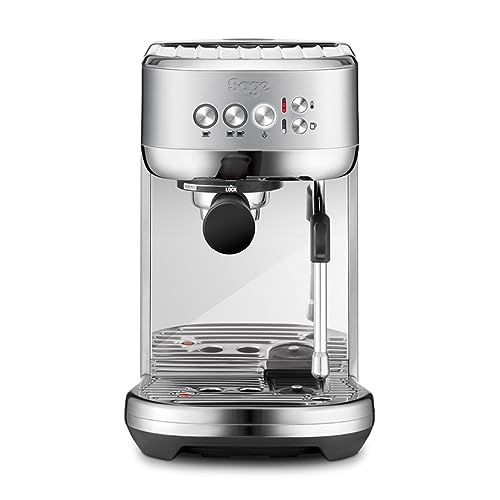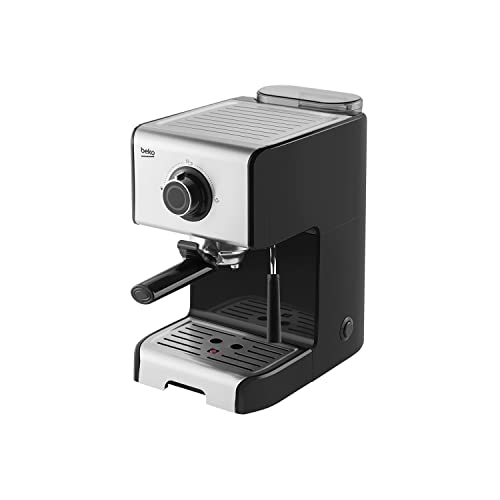10 Things We All Love About Espresso Machine
작성자 정보
- Angelika 작성
- 작성일
본문
Important Parts of an Espresso Machine
 A high-quality espresso machine will produce a shot of coffee with a dense body, a rich flavor and an intense aroma. This requires high temperature and pressure.
A high-quality espresso machine will produce a shot of coffee with a dense body, a rich flavor and an intense aroma. This requires high temperature and pressure.
Also, be aware of the crema, a golden brown layer that gives the espresso its characteristic flavor and color. There are four types of espresso machines. They include semi-automatic, automatic, and manual.
Water reservoir
The reservoir for water is the container that houses the cold, filtered water that is fed to the best espresso maker machine. It is usually movable and comes with lids that keep the water clean and free of dust. It is a vital component of an espresso machines uk maker and must be kept clean to avoid clogging. Pour vinegar into the reservoir to cleanse it. Allow it to run for a while.
The espresso machine makes use of water to pressurize coffee grounds to extract flavors oils, caffeine and flavors. It also produces crema, which is the foam. The first espresso machines were created by Achille Gaggia, who used pistons tethered to levers in order to create high-pressure coffee. Gaggia's spring-piston levers moved the water through the coffee and into the cup, introducing new jargon for what was referred to by consumers as "coffee cream" (crema).
The pump is a device that utilizes electricity to push water through the heating element to heat it to the ideal brewing temperatures of 195 degrees Fahrenheit. The pump is usually located at the bottom of the machine. It is connected to a tube that goes through the heating elements. The tube is connected at the other end to both the cold-water and hot-water tubes. It also goes under the resistive heating elements which are coated with white grease to keep the plate warm.
Pump
The pump is the thing that makes espresso machines work with, and there are various types. Some machines employ a vibration pump or a vibration pump which uses an electromagnetic motor to move back and forth in the form of a coil at 60 pushes per second. The pump forces water into the portafilter, and mini espresso maker then out of the spouts. Other pumps utilize thermoblocks or a thermocoil heating system, which will precisely heat the water to the temperature that is desired for the brewing. These systems permit the control of temperature and pressure, both of which are essential for a high-quality extraction.
 Pump-driven mini espresso maker machines may employ a spring, piston or electric pump. But, they all require that water be moved through the coffee grounds at high pressure. The higher the pressure, more delicious the extraction. The pump also ensures that the coffee ground is evenly distributed, which can help create a great crema.
Pump-driven mini espresso maker machines may employ a spring, piston or electric pump. But, they all require that water be moved through the coffee grounds at high pressure. The higher the pressure, more delicious the extraction. The pump also ensures that the coffee ground is evenly distributed, which can help create a great crema.
Steam-driven and piston-driven espresso machine sale machines are also available. In a steam-driven machine, the water is forced through the coffee using steam pressure. This type of espresso machine is more affordable, but doesn't produce as much pressure for the extraction. There are also air-pump-driven espresso machines, which are lighter and smaller in size, but do not require a boiler and can be powered by hand pumps or a canister of compressed air (such as CO2 or N2). Pump-driven espresso maker for home makers use less pressure than espresso machines driven by pumps, but they may be more convenient for some.
Steam tool
The steam wand is the thin pipe made of metal that comes from the espresso machine and releases steam that is hot and pressurized into the milk to create foamy drinks such as cappuccinos and lattes. You can also make hot coffee or cocoa. The wand is usually made of several holes in the tip which you can switch off and on to control how much steam is released. Some machines use an old-fashioned wand, while others have a Pannarello wand, which is easier to use but does not create the same foam that is required for latte art.
If you're having trouble frothing your milk, you might be having a problem with the anti-vacuum valve of your espresso machine. The valve was designed to stop air from getting absorbed into the steam wand while it is in operation. You can test this by lowering the wand, and listening for a hissing sound. If you hear a sound that is hissing it is a sign that air is being drawn in. You should raise the wand to let it submerge completely.
You can also test the anti-vacuum using the wand and then cleaning it in warm water with a soft bristled brush or sponge. Cleaning the wand is essential to avoid clogs that may affect your frost. If you are unable to fix it on your own, seek help from a technician or the manufacturer.
Control panel
The control panel of an espresso machine permits users to set up and modify settings. These include coffee strength and milk volume. These settings are stored in memory and can be modified at any time. The display also indicates when the machine must be descaled as well as whether the tank is full.
Most espresso machines espresso have hot-water dispensers, either adjacent to one of the groups or in between them. It can be used to make tea or heat cups, when needed. It is also ideal for cleaning and washing. A lot of models have gauges for pressure on the front of the machine, indicating the current pressure in the boiler.
There is also a brew switch which controls the brew cycle and the number of shots. This is important since espresso shot size is determined by the length of time that the grounds are in contact with water. If you wish the switch could be used to initiate the steaming process.
The control system for this espresso machine is outdated however it has easy-to use features. It has a narrow LCD screen that appears like an LED. This makes it easy to navigate the menus, although there is some learning curve for users that are new to espresso machines. The stability of the temperature is impressive as well. It maintains a consistent water temperature between 194deg and 208deg F during the entire brewing process. This ensures a perfect extraction of aroma and a premium cup each time.
 A high-quality espresso machine will produce a shot of coffee with a dense body, a rich flavor and an intense aroma. This requires high temperature and pressure.
A high-quality espresso machine will produce a shot of coffee with a dense body, a rich flavor and an intense aroma. This requires high temperature and pressure.Also, be aware of the crema, a golden brown layer that gives the espresso its characteristic flavor and color. There are four types of espresso machines. They include semi-automatic, automatic, and manual.
Water reservoir
The reservoir for water is the container that houses the cold, filtered water that is fed to the best espresso maker machine. It is usually movable and comes with lids that keep the water clean and free of dust. It is a vital component of an espresso machines uk maker and must be kept clean to avoid clogging. Pour vinegar into the reservoir to cleanse it. Allow it to run for a while.
The espresso machine makes use of water to pressurize coffee grounds to extract flavors oils, caffeine and flavors. It also produces crema, which is the foam. The first espresso machines were created by Achille Gaggia, who used pistons tethered to levers in order to create high-pressure coffee. Gaggia's spring-piston levers moved the water through the coffee and into the cup, introducing new jargon for what was referred to by consumers as "coffee cream" (crema).
The pump is a device that utilizes electricity to push water through the heating element to heat it to the ideal brewing temperatures of 195 degrees Fahrenheit. The pump is usually located at the bottom of the machine. It is connected to a tube that goes through the heating elements. The tube is connected at the other end to both the cold-water and hot-water tubes. It also goes under the resistive heating elements which are coated with white grease to keep the plate warm.
Pump
The pump is the thing that makes espresso machines work with, and there are various types. Some machines employ a vibration pump or a vibration pump which uses an electromagnetic motor to move back and forth in the form of a coil at 60 pushes per second. The pump forces water into the portafilter, and mini espresso maker then out of the spouts. Other pumps utilize thermoblocks or a thermocoil heating system, which will precisely heat the water to the temperature that is desired for the brewing. These systems permit the control of temperature and pressure, both of which are essential for a high-quality extraction.
 Pump-driven mini espresso maker machines may employ a spring, piston or electric pump. But, they all require that water be moved through the coffee grounds at high pressure. The higher the pressure, more delicious the extraction. The pump also ensures that the coffee ground is evenly distributed, which can help create a great crema.
Pump-driven mini espresso maker machines may employ a spring, piston or electric pump. But, they all require that water be moved through the coffee grounds at high pressure. The higher the pressure, more delicious the extraction. The pump also ensures that the coffee ground is evenly distributed, which can help create a great crema.Steam-driven and piston-driven espresso machine sale machines are also available. In a steam-driven machine, the water is forced through the coffee using steam pressure. This type of espresso machine is more affordable, but doesn't produce as much pressure for the extraction. There are also air-pump-driven espresso machines, which are lighter and smaller in size, but do not require a boiler and can be powered by hand pumps or a canister of compressed air (such as CO2 or N2). Pump-driven espresso maker for home makers use less pressure than espresso machines driven by pumps, but they may be more convenient for some.
Steam tool
The steam wand is the thin pipe made of metal that comes from the espresso machine and releases steam that is hot and pressurized into the milk to create foamy drinks such as cappuccinos and lattes. You can also make hot coffee or cocoa. The wand is usually made of several holes in the tip which you can switch off and on to control how much steam is released. Some machines use an old-fashioned wand, while others have a Pannarello wand, which is easier to use but does not create the same foam that is required for latte art.
If you're having trouble frothing your milk, you might be having a problem with the anti-vacuum valve of your espresso machine. The valve was designed to stop air from getting absorbed into the steam wand while it is in operation. You can test this by lowering the wand, and listening for a hissing sound. If you hear a sound that is hissing it is a sign that air is being drawn in. You should raise the wand to let it submerge completely.
You can also test the anti-vacuum using the wand and then cleaning it in warm water with a soft bristled brush or sponge. Cleaning the wand is essential to avoid clogs that may affect your frost. If you are unable to fix it on your own, seek help from a technician or the manufacturer.
Control panel
The control panel of an espresso machine permits users to set up and modify settings. These include coffee strength and milk volume. These settings are stored in memory and can be modified at any time. The display also indicates when the machine must be descaled as well as whether the tank is full.
Most espresso machines espresso have hot-water dispensers, either adjacent to one of the groups or in between them. It can be used to make tea or heat cups, when needed. It is also ideal for cleaning and washing. A lot of models have gauges for pressure on the front of the machine, indicating the current pressure in the boiler.
There is also a brew switch which controls the brew cycle and the number of shots. This is important since espresso shot size is determined by the length of time that the grounds are in contact with water. If you wish the switch could be used to initiate the steaming process.
The control system for this espresso machine is outdated however it has easy-to use features. It has a narrow LCD screen that appears like an LED. This makes it easy to navigate the menus, although there is some learning curve for users that are new to espresso machines. The stability of the temperature is impressive as well. It maintains a consistent water temperature between 194deg and 208deg F during the entire brewing process. This ensures a perfect extraction of aroma and a premium cup each time.
관련자료
-
이전
-
다음
댓글 0
등록된 댓글이 없습니다.
